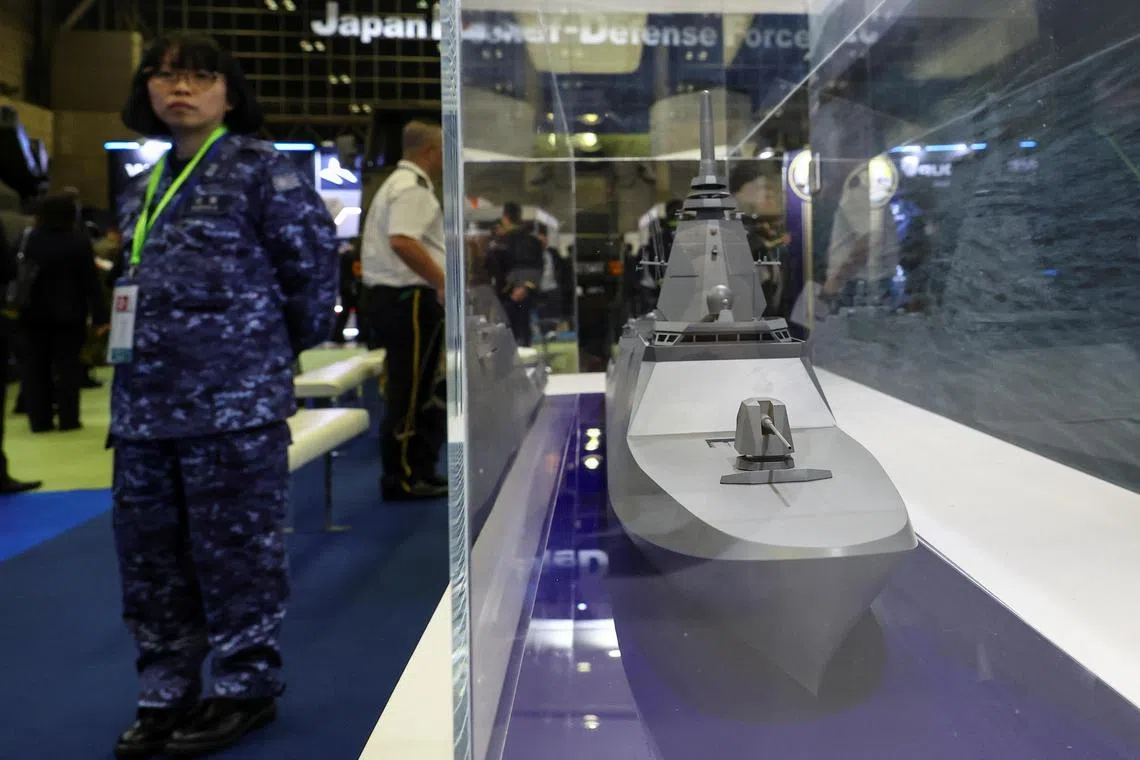Australia to buy 11 advanced warships from Japan
Sign up now: Get ST's newsletters delivered to your inbox

A model of a Mogami-class vessel displayed during a defence security equipment exhibition in Chiba, east of Tokyo, on May 21.
PHOTO: REUTERS
Follow topic:
SYDNEY – Australia will upgrade its navy with 11 Mogami-class frigates built by Japan’s Mitsubishi Heavy Industries, Defence Minister Richard Marles said on Aug 5.
Australia will pay US$6 billion (S$7.7 billion) over the next 10 years to acquire the fleet of stealth frigates, in what has been billed as one of Japan’s biggest defence export deals since World War II.
Australia is in the midst of a major military restructure, bolstering its navy with long-range firepower in an effort to deter China.
It is striving to expand its fleet of major warships from 11 to 26 over the next 10 years.
“This is clearly the biggest defence industry agreement that has ever been struck between Japan and Australia,” Mr Marles said, touting the deal.
“This decision was made based on what was the best capability for Australia,” he added. “We do have a very close strategic alignment with Japan.”
Mogami-class warships are advanced stealth frigates equipped with a potent array of weapons.
Mr Marles said they would replace Australia’s ageing fleet of Anzac-class vessels, with the first Mogami-class ship to be in service by 2030.
“The Mogami-class frigate is the best frigate for Australia,” he said. “It is a next-generation vessel. It is stealthy. It has 32 vertical launch cells capable of launching long-range missiles.”
The deal further cements a burgeoning security partnership between Australia and Japan.
Japan is deepening cooperation with US allies in the Asia-Pacific region that, like Tokyo, are involved in territorial disputes with China.
Both Japan and Australia are members of the so-called Quad group alongside India and the US.
Japanese government spokesman Yoshimasa Hayashi said on Aug 5 that the deal was “proof of trust in our nation’s high-level technology and the importance of interoperability between Japan’s Self-Defence Forces and the Australian military”.
It was also a “big step towards elevating the national security cooperation with Australia, which is our special strategic partner”, Mr Hayashi told reporters in Tokyo.
‘More lethal’
Japan’s pacifist Constitution restricts it from exporting weapons – but Tokyo has in recent years loosened arms export controls to boost sales abroad.
“This is Japan’s largest defence export deal since 1945 with a non-US partner,” said Professor Heng Yee Kuang from the University of Tokyo’s Security Studies Unit.
“And only the second since Tokyo loosened its guidelines on defence exports in 2014, which led to exports of air surveillance radar to the Philippines.”
Prof Heng said the deal was a “massive shot in the arm” for Japan as it sought to strengthen its defence manufacturing industry.
Australian Defence Industry Minister Pat Conroy said the Mogami-class frigates were capable of launching long-range Tomahawk cruise missiles.
“The acquisition of these stealth frigates will make our navy a bigger navy and a more lethal navy,” he said.
The first three Mogami-class frigates will be built overseas, Mr Conroy said, with shipbuilding yards in Western Australia expected to produce the rest.
Australia announced plans in 2021 to acquire US-designed nuclear-powered submarines, scrapping a years-long plan to develop non-nuclear subs from France.
Under the tripartite Aukus pact with the US and the United Kingdom, the Australian navy plans to acquire at least three Virginia-class submarines within 15 years.
The Aukus submarine programme alone could cost the country up to US$235 billion over the next 30 years, according to Australian government forecasts, a price tag that has stoked criticism of the strategy.
Major defence projects in Australia have long suffered from cost overruns, government U-turns, policy changes and project plans that make more sense for local job creation than defence.
Australia plans to gradually increase its defence spending to 2.4 per cent of gross domestic product – above the 2 per cent target set by its Nato allies, but well short of US demands for 3.5 per cent. AFP

